High-quality processing of metal parts is impossible without the use of a sharpened tool, in particular, drills. A blunt tool can be restored to sharpness using industrial sharpeners or by making a device for sharpening a drill for metal with your own hands. But, the working part of different drills in size and purpose has differences in factory sharpening.
Content
The subtleties of sharpening drill
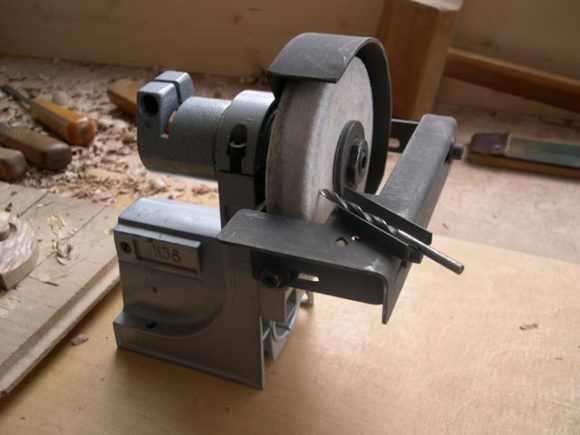
Depending on the declared purpose, metal drills can have a separate type of sharpening. This parameter also varies with thickness. The single-plane type of sharpening is applicable only for diameters up to 3 mm. Such drills are used for small jobs, more often in electronics and modeling. Two-plane drills are applicable in most household tasks, depending on the diameter. The conical type of sharpening is classified as a narrowly oriented tool - a universal diameter drill is used to prepare holes in aluminum sheets. When sharpening tips use the following techniques:
- Manual sharpening - can be done using a bar or file. The disadvantage is the difficulty of maintaining the angle, which leads to a mismatch in the symmetry of the cutting edge.
- Household machines - devices for maintaining a strict sharpening angle. If the mechanism is factory-made, then it can be set to the exact angle and set only the extreme part.
- Industrial drill sharpening equipment is distinguished by high power. The procedure takes place in a semi-automatic mode - just insert the drill into the groove of the desired diameter and set the angle.
Industrial devices in the household version have simplified analogues with fastening to an electric drill. With a wide selection of diameters, you can sharpen all the drills for the household.
As a separate type of instrument for sharpening a tool, an electric sharpener is isolated. This device is referred to as a universal technique, since more manipulations can be performed on it. When sharpening the drill on an electric sharpener, you need to hold the tool firmly, since the rotation of the emery wheel pulls it out of your hands and knocks the angle.
What drills and when sharpen
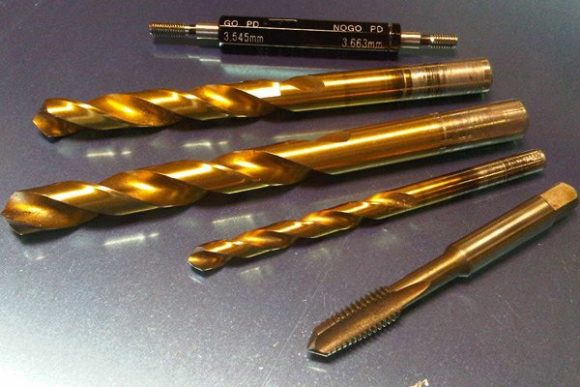
Feather and other types of wood drills are not sharpened on their own, due to the fact that the cutting part has a difference in shape from conical. Pobeditovye tips for drilling concrete are rarely dull, and if necessary, sharpening is best carried by a professional. Spiral drills for metal, are more common as a tool, they are often used for other purposes - for plastics and wood.
The cutting part of the twist drills is small, therefore, when drilling holes in dense material, significant heating occurs. The temperature decreases the strength of the material and the tool becomes dull. Often the reason lies in the improper use of the drill - deviations from the initial angle lead to an increase in friction on one side, which damages the cutting edge. It is possible to determine when the cutting part has already become dull by a number of signs:
- heating the tool without moving deeper into the material;
- the chips come out only one-sided;
- instead of shavings, metal dust flies out of the channels;
- when drilling a creak is heard.
It is impossible to continue working with such a tool, as blunting of the cutting part will only progress. So that the edge is not spoiled when sharpening the drill with your own hands, determine the initial angle. To do this, use a goniometer, and in its absence, use the tool that is at hand, for example, a protractor and a square. The result is detected in the range from 90 ° (brittle metals - magnesium, silumin, electron) to 140 ° (aluminum, wood and plastics).
They do not recommend changing the angle, since there are differences in the structural features of the spiral for different purposes.
General classification of household sharpening devices
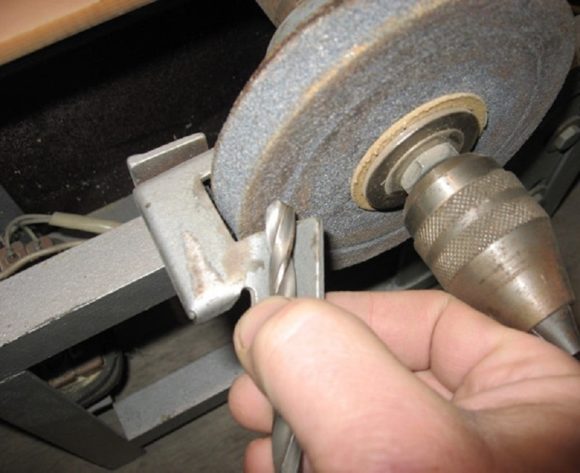
Household sharpening machines - easy to operate, since all setup is already enclosed in a shell. The dimensions of the drills that can be sharpened and the application methods depend on the specified parameters. On some devices you need to set the exact angle, and on others you can make adjustments to the initial angle of the tip, while maintaining the native sharpening. General classification by machine tools:
- Nozzles - machines designed to fix on the head of a drill or other apparatus equipped with a motor. They can sharpen a limited number of sizes, depending on the marking.
- Individual devices are similar in structure to nozzles, but they have their own engine. On the case there are legs for installing the device on a workbench.
- Home-made designs with an individual drive or designed for combined work with an electric sharpener. It is possible to equip mounting parts to a workbench or bed.
Home-made varieties of tools for sharpening a tool are more universal, therefore, it is preferable. Sharpening mechanisms, which complement the drill, are covered by a casing, so there is no danger of a sudden spark. Electrical appliances for household sharpening of cutting edges are often a multidisciplinary tool, among the purposes of which there are mechanisms for sharpening knives and scissors.
Homemade design
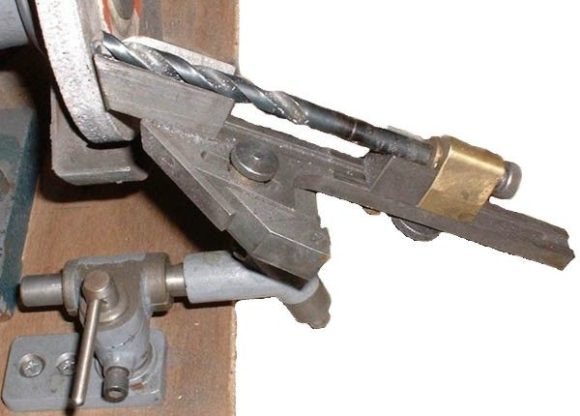
The simplest tool sharpening tool is made of a metal tube. The inner diameter of such a part should match the outer diameter of the drill. The sleeve itself must be fixed on a fixed basis with the calculation of the angle relative to the sharpener plane. As a base for such homemade work, a wooden block is cut at the angle necessary for sharpening.
When it is necessary to ensure the versatility of the device, they procure tubes of all sizes or drill holes in the bar according to the diameters. Similar designs were previously common in home use. By changing the size of the bar and making an additional stop, you can get a reliable tool for precise grinding of edges on the electric sharpener.
The material for the base is chosen durable and not fragile - completely dried wood does not always pass by such qualities. Fresh wood is also not recommended - after the material has dried, the holes will dry out and cracks will appear.
Sharpening on simple tools
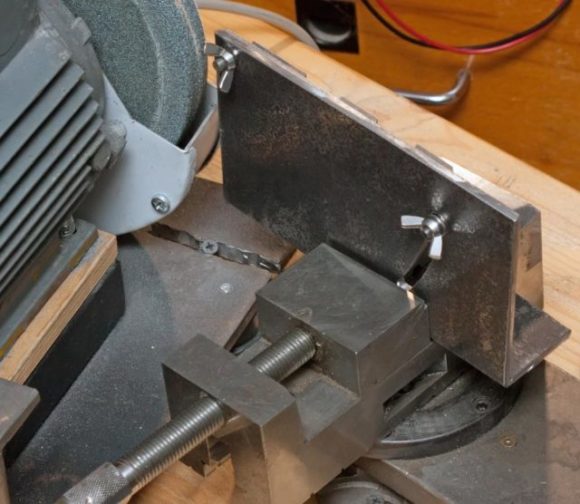
Before sharpening the nozzle on a drill at home with the help of an electric sharpener and a homemade device, you need to ensure your own safety. To do this, prepare gloves (coarse gloves), safety glasses (face shield) and a respirator. This need is due to the fact that when turning hard metal on a emery wheel, a large number of sparks scatter. The algorithm for sharpening is as follows:
- The processing of the falling edges of the tip is carried out at an angle to the grinding wheel. With a small thickness, apply a plane several times. With a large thickness of the wiring, you need to do it with a slight turn, reducing it to a conical shape.
- The cutting edge is ground with light movements with the direction of the blade towards the rotation of the circle.The shape of the edge must be maintained according to the original version.
- The jumper on the tip of the drill cannot be grinded, but it should be no more than 0.4 mm - an approximate parameter for medium-sized household tools. It needs to be grinded if necessary.
When the drill is less than 3 mm thick, the grinding process is slightly different - the falling edge of the tip is only one, so the procedure is simplified. 1 approach should take no more than 2-3 seconds, otherwise the tool will overheat. This will also negatively affect the sharpening - excessively sawn edges will render the tool unusable. If this is the first attempt to sharpen the drill, it is recommended to use already unusable ones.
Hand holder
To sharpen the drill, you can use hand holders. This design in its own structure does not have any technological parts. The drill is fixed in the groove, and the wings on the sides help to withstand the angle relative to the surface of the emery wheel or stone. The main purpose of the hand holder is to protect your hands when sharpening a tool. Among the advantages are:
- quick availability;
- small size of the device;
- ease of use;
- low price.
When using a hand holder, there is a need to manually maintain the angle. The result of use differs little from sharpening without fixtures.
The advantages of specialized units
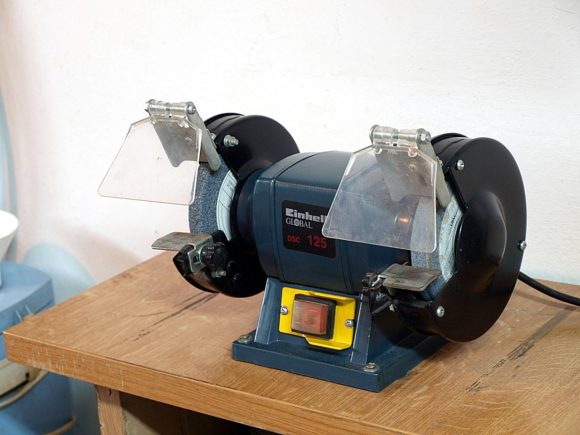
Specialized devices have a design that is different from homemade products, which allows you to withstand accurate sharpening angles in automatic mode. The drill must be placed in the hole of the appropriate diameter and the device is turned on. Since the tool is rigidly fixed in the groove, all sharpening moments will be close to ideal. But, the accuracy of adjustment from such equipment should not be expected.
After several applications, the plane of the circle inside the device will not be whole, then there will be distortions along the cutting edge. It is not worth using a tool with constant debugging for profile drills, since the angle of the descending edges will differ from the generally accepted standard. In such situations, it is better to use a professional tool or contact the master.
Emphasis for an electric sharpener
The emphasis is attributed to universal auxiliary tools for electric sharpeners. It is set depending on the desired position for holding the part or maintaining the angle when sharpening the drill. At most stops there is marking to change position relative to the abrasive wheel. Such marking allows you to quickly set the desired angle and carry out accurate work.
The main disadvantage of such a device for sharpening with your own hands is the need to hold the tool by force. Some types of stops can be fixed not on the sharpener itself, but on the workbench - the degree of adjustment is expanded, so the sharpening procedure is simplified. Such devices are universal and they are used for all types of electric sharpeners.
Tool for sharpening drill bits from a nut
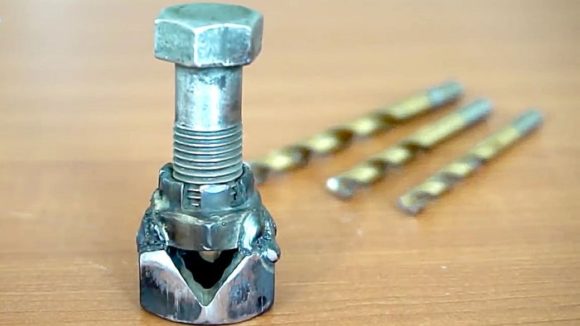
A simple version of the device for accurately maintaining the angle when sharpening can be made of a nut. The basis is the main detail of the design. The shape of the nut is in the shape of an exact hexagon - the angle between each pair corresponds to the standard for universal household drill bits for metal of 120 °. For manufacturing, cuts are made between opposite angles - the design is simple, therefore, drawings are not required. To simplify the work with the device, it is often modified as follows:
- the nut for the base is chosen larger;
- cuts are made by the size of the largest drill;
- a nut of a smaller diameter is welded on top of the cuts;
- how to fix a bolt with a lamb.
It is impossible to tighten strongly hard - this way you can bend or break the sharpened tool.
It is not difficult to use a homemade device made of nuts - the drill is installed in a groove on opposite sides and fixed by slightly exposing the cutting part.The planes of the main nut act as a limiter. After fixation, the right side is applied to the rotating emery wheel. If the fixture is made without a latch, you need to fasten the structure in a vise and grind the edge with a file, bar or grinder.
The use of emery circles and features of their choice
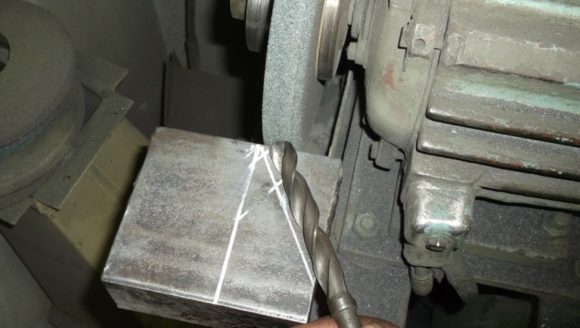
For universal household use of electric power, white circles are selected from electrocorundum with a grain size of 25H. They are suitable for primary processing of various metal billets and sharpening household tools (knives, axes, shovels). If you need to sharpen drills, it is better to choose an abrasive wheel made of silicon carbide. For initial grinding, grain size 16H is suitable, and for finishing 8H.
When working with an abrasive wheel, pauses should be maintained - 2-3 sets and cooling. This is due to the fact that carbide wheels become very hot during use. If you need to speed up the work process to cool the drill, you can dip it in water at room temperature with the addition of soda. The plane on the disk should be flat - if there is distortion, rule the surface with the help of an elbor cutter. The direction of emery rotation determines the effectiveness of edge grinding. Sharpening will be successful if the abrasive runs on a cut.
After completing the grinding of the tip, fine-tuning is carried out. Such a procedure is necessary to remove fine roughness at the points of contact of the tool with the material. The surface should be smooth so that the drill does not overheat during operation. For fine-tuning use fine-grained stones and emery circles. Additionally, you can go along the cutting edge with polishing paste.
Conclusion
Sharpening drills for metal is not difficult; for this, many devices of different directions are manufactured, both industrial production and home-made devices. But, when sharpening, you need to take into account the differences between different tools for the angle of the cutting edge. An equally important role is played by the choice of grit size of the emery wheel - large values strongly grind the surface and leave roughness, which subsequently needs to be eliminated.

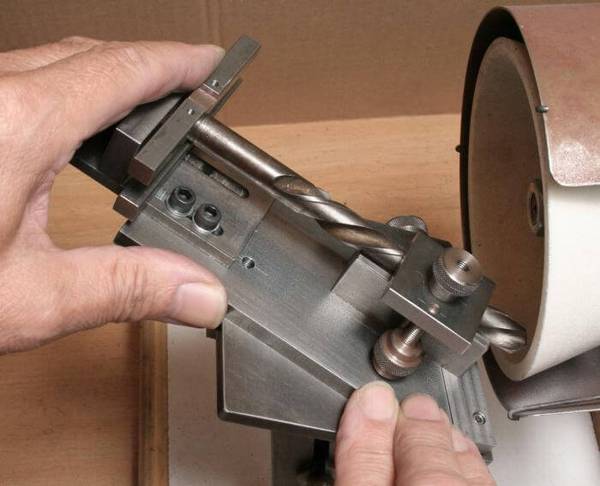
Alas, no comments yet. Be the first!